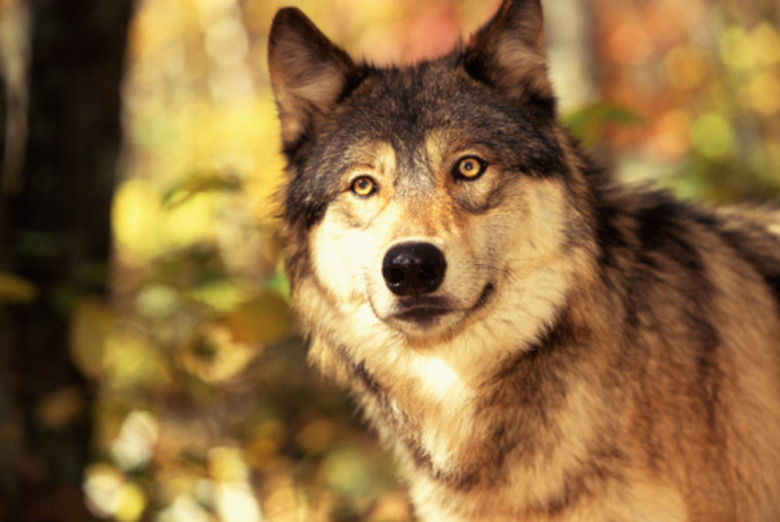What States & Continents Do Wolves Live In?
Long considered a danger to livestock and painted to be dangerous creatures in mythology and literature, wolves have been trapped and hunted almost to extinction throughout the world. Loss of habitat drove them to more remote areas, where they went unseen. Surprisingly, the wolf population has thrived in some areas, and thanks to human intervention, it has even made a comeback in places it had been thought to be extinct.
TL;DR (Too Long; Didn't Read)
Once populous throughout North America, Asia and Europe, wolves still can be found in most of North America, Europe and Asia, albeit in much smaller numbers.
The largest member of the canid family, wolves average about 30 inches tall at the shoulder and weigh about 65 pounds. There are many subspecies of wolves with significant differences seen in body size, fur color and size of the skull.
Wolves live in packs, which vary in size depending on available prey. They are social animals; each pack is led by a mating pair and an assortment of both of related and unrelated individuals. The pack works together to hunt and to protect their kills from other animals within a given territory that ranges from 20 to 120 square miles. They eat animals both large and small and can go a week without eating. When their meals are infrequent, each wolf can eat up to 20 pounds at one time.
Preferred Wolf Habitat
Preferred Wolf Habitat
Their choice of habitat depends on the amount of available prey as well as the amount of wild space. Most wolves prefer continuous stretches of forested land, though any area with available prey and safe hiding spaces for dens will do.
Wolves can be found throughout the Northern Hemisphere. Gray wolves have been found as far north as the Canadian Arctic and as far south as India. The gray wolf was once common throughout North America, Asia and Europe, but it is now generally only seen in some areas of Alaska, Canada, northern Mexico and the northern U.S., as well as parts of Europe and Asia. Other wolf species are also found in North America.
Gray Wolf Facts
Gray Wolf Facts
The population of gray wolves, also known as timber wolves, in the U.S. is estimated to be over 13,000, with the majority living in Alaska. In the Northern Rocky Mountains, gray wolves are found in Idaho, Montana and Wyoming, and there is evidence they have begun to migrate into Oregon and northern California.
In addition to the gray wolf, the eastern wolf is found in southeastern Canada and the northeastern U.S. Thought to be separate from the gray wolf, it may be a hybrid of a gray wolf and a coyote. One estimate puts the eastern wolf population at 450 and 2,620. The Mexican wolf, the rarest subspecies of the gray wolf, was almost eliminated in the 1970s, but this species now numbers over 100, generally in southern New Mexico and Arizona.
Northern wolves tend to be larger in size than those in southern states. Males, which are larger than females, tend to be about 26 to 32 inches at the shoulder and weigh 70 to 115 pounds. Gray wolves appear to be quite versatile; they are able to survive in many biomes, from the Arctic tundra to dense forests, in both mountains and dry shrub lands.
Red Wolf Population
Red Wolf Population
The red wolf weighs between 50 and 80 pounds and stands about 26 inches at the shoulder. Originally found from eastern Texas to the East Coast and as far north as southern New York, by 1970 their habitat was confined to coastal Texas and Louisiana, The species was declared extinct in the wild in 1980. Today the red wolf has been reintroduced to the wild and can be found in northeastern North Carolina.
European and Western Asian Wolves
European and Western Asian Wolves
Like in the U.S, overzealous hunting and trapping severely reduced the Eurasian wolf populations in all but Eastern Europe. In recent years, the gray wolf population appears to be increasing in central Europe. It is believed that this is due to efforts to protect the species as well as the wolf's transition from farmlands to forest in some areas. A study of Carpathian wolves show that genetically, they are separate from North American gray wolves and instead are more like their Ice Age ancestors. Another species of gray wolf, the Eurasian wolf, also is much reduced in number, with the largest population found in Russia.
No True Wolves in South America
No True Wolves in South America
An animal called a maned wolf lives in South America that looks like a fox with very long legs. While it is the largest canid species in South America, it is neither a fox nor a wolf, but a completely different species.
References
- National Park Service: Yellowstone: Wolves
- Michigan Department of Natural Resources: Wolf Biology and Identification
- New Hampshire Fish and Game: Eastern Wolf
- University of Ostrava: The Meeting of Wolves at the Genetic Junction in Central Europe
- U.S. FIsh & Wildlife Services: Mexican Wolf Recovery
- Environment and Climate Change Canada: Management Plan for the Eastern Wolf (Canis Lupus Lycaon) in Canada
Cite This Article
MLA
Yavorski, Kimberly. "What States & Continents Do Wolves Live In?" sciencing.com, https://www.sciencing.com/states-continents-do-wolves-live-8517357/. 15 October 2018.
APA
Yavorski, Kimberly. (2018, October 15). What States & Continents Do Wolves Live In?. sciencing.com. Retrieved from https://www.sciencing.com/states-continents-do-wolves-live-8517357/
Chicago
Yavorski, Kimberly. What States & Continents Do Wolves Live In? last modified March 24, 2022. https://www.sciencing.com/states-continents-do-wolves-live-8517357/
